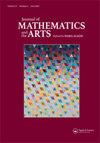Hyperbolic paper sculptures
IF 0.2
Q4 MATHEMATICS, INTERDISCIPLINARY APPLICATIONS
引用次数: 0
Abstract
Topology was one of my favourite subjects at university, but it took a while for me to really explore the possibilities of presenting my drawings on mathematical sculptures. I started using my drawings as the content for artist’s books early on. Then, in 2000, I began playing withMöbius strips, one-sided surfaces. I developed theHappersett Accordion, a folded version of the Möbius strip. By alternating the colours of the drawings on each folded section, I was able to create a Möbius strip with two distinct faces. Ivars Peterson wrote about it in 2001: ‘ . . . a novel twist on the Möbius strip; a playful eye-catching creation . . . ’ (2001). In 2005, I sawDaina Taimina present her hyperbolic forms at the CUNYGraduate Center in New York. Taimina had found paper models too fragile for use as classroommodels, so she used crocheted yarn as the medium. I got to work crocheting my own hyperbolic form, forme, it was a slowprocess. I wanted to find a quickway tomake hyperbolic inspired forms that could be used in an art class. I returned to paper, using card stock tomake sculptures with drawings that were not necessarily going to be handled as much as classroom models. My next paper form was the Circle Hyperbolic. Taking two identical circles each with a radial slit, I combined them by overlapping them by 45 degrees and gluing them together. This starts a spiral. By unspiralling the form so that other edges of the slits can be overlapped and attached, a saddle shape is formed. The resulting sculpture answers the question of what happens if a circle hadmore than 360 degrees or, in this case, 630 degrees? By using the same method to combine three circles into a form with 945 degrees a ruffle started to appear. ‘Chaos Hyperbolic’ (Figure 1) consists of three circles and features my chaos fractal drawings. In 2014, MOMA presented a Lygia Clark retrospective. I was fascinated by the kinetic nature of the hinged metal sculptures. I wrote about them in my blog (Happersett, 2014): ‘ Clark created these sculptures so the viewer could manipulate the shapes creating different forms . . . ’. I even showed how to reproduce one of the simpler forms using tape and cardboard. This led me to explore more complicated shapes with hinges. Over the past few years, I have been making my lace drawings within the confines of quadrilaterals. I decided to try my hand at hyperbolic forms using squares to showcase these drawings. I started with a set of identical squares, each with a single slit running双曲纸雕塑
拓扑学是我在大学最喜欢的科目之一,但我花了一段时间才真正探索在数学雕塑上展示我的绘画的可能性。我很早就开始用我的画作为艺术家书籍的内容。然后,在2000年,我开始打withMöbius条,单面。我开发了哈伯塞特手风琴,一个折叠版本的Möbius条。通过在每个折叠部分上交替绘制颜色,我能够创建一个具有两个不同面的Möbius条带。伊瓦尔斯·彼得森(Ivars Peterson)在2001年写道:“……Möbius漫画上的新奇转折;一个有趣的引人注目的创作…”(2001)。2005年,我在纽约市立大学研究生中心看到黛娜·泰米娜(daina Taimina)展示了她的双曲形式。泰米娜发现纸模型太脆弱,不适合用作课堂模型,所以她用钩针编织的纱线作为媒介。我开始编织我自己的双曲线,对我来说,这是一个缓慢的过程。我想找到一种快速的方法来制作双曲的灵感形式,可以在艺术课上使用。我回到了纸上,用卡片制作雕塑,这些雕塑不一定像课堂模型那样需要处理。我的下一个论文形式是圆双曲。取两个相同的圆,每个圆都有一个径向的缝隙,我把它们重叠45度,然后把它们粘在一起。这就开始了螺旋式上升。通过解开螺旋形,使狭缝的其他边缘可以重叠并附着,形成鞍形。由此产生的雕塑回答了这样一个问题:如果一个圆超过360度,或者在这个例子中,超过630度,会发生什么?用同样的方法把三个圆组合成一个945度的形状,就出现了皱褶。“混沌双曲”(图1)由三个圆组成,并以我的混沌分形图为特色。2014年,MOMA举办了Lygia Clark回顾展。我被铰链金属雕塑的动态特性所吸引。我在我的博客中写过这些雕塑(hapersett, 2014):“克拉克创造了这些雕塑,这样观众就可以操纵它们的形状,创造出不同的形式……”。我甚至展示了如何用胶带和纸板复制一个更简单的形式。这让我开始探索更复杂的铰链形状。在过去的几年里,我一直在四边形的范围内画花边画。我决定尝试用正方形的双曲形式来展示这些画。我从一组相同的正方形开始,每个正方形都有一条狭缝
本文章由计算机程序翻译,如有差异,请以英文原文为准。
求助全文
约1分钟内获得全文
求助全文
来源期刊

Journal of Mathematics and the Arts
MATHEMATICS, INTERDISCIPLINARY APPLICATIONS-
CiteScore
0.50
自引率
0.00%
发文量
19
 求助内容:
求助内容: 应助结果提醒方式:
应助结果提醒方式:


